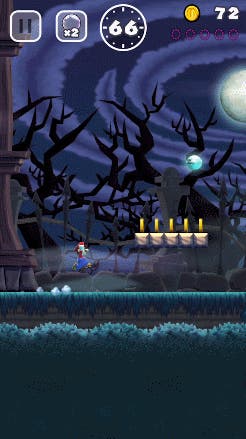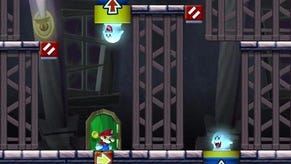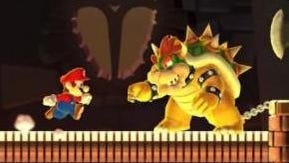Super Mario Run sees Nintendo's mascot leap confidently onto iPhone
Sprint screen.
Super Mario Run launches Nintendo's biggest franchise onto the screens of iPhones and iPads for the very first time (Android comes later) and it looks, on the surface at least, exactly like New Super Mario Bros. - a series which has become a best-selling staple of Nintendo's home consoles and handhelds.

It's a strange sight, the first time Mario jogs onto your iPhone. Nintendo waited so long to jump into mobile game development it felt like the day would never come. And yet there he is, with his portly run and trademark dungarees, leaping and landing in a brave new world.
If you're expecting a straightforward port of 2D Mario game you'll be surprised - with its one-handed controls and touchscreen jumping, Super Mario Run immediately feels like a very different animal. Likewise, if you heard the game's name and equated it to one of the App Store's endless runners, you're also mistaken. Mario's iPhone debut ends up landing somewhere in the middle.
As its name suggests, Super Mario Run presses our plumber pal into a non-stop sprint so you can play one-handed and only worry about controlling his jumps. It's a big change for long-time Mario fans, and one which takes getting used to. For me, playing a 2D Mario requires I sometimes stop and judge the distance between blocks, sprint and then control Mario's landing accordingly. Super Mario Run affords you no such luxury.
There are ways to briefly disrupt Mario's ever-forwards movement and different paths through each level to follow, usually in pursuit of some hard-to-snag collectible, but these are exceptions rather than the norm. Super Mario Run's one-handed approach to gameplay can sometimes feel like too big a concession from New Super Mario Bros. for long-time fans of that series. It's frantic, which is fine, but it can also leave you feeling like the game isn't giving you enough time to see where you're going before the level has already passed under your feet.
The way to counteract this, of course, is practice, and Super Mario Run's quick burst platforming levels feel the right length to be replayed over and over. It's going to take you a while to work out and then perform the feats needed to nab everything on offer. Even a second and third playthrough of some areas left me scratching my head. But, pleasingly, the more you play, the more you find to master. Mario might move at a breakneck pace and not give you a lot of time to react, but his move-set is as versatile as it has ever been. More so, in fact. For anyone worried about whether simply tapping a screen to jump would be interesting enough - it's quite the opposite.
Mario can roll jump, long jump, vault jump, perform a landing roll, parkour roll over enemies or pull off a stall jump to slow things down. He can even mantle up onto ledges. Super Mario Run hosts his most diverse 2D move-set ever - and also the most forgiving, thankfully, for a game which forces you to react as fast as possible, using one hand, probably on the tube while someone is elbowing you in the back.
Pause Blocks let you take a second to breathe and analyse the level in front of you, and usually appear before a collectible you'll need to react quickly to reach. Alternatively, you could decide to use your new stall jump move by tapping and dragging backwards to slow Mario's speed. Or, you can gamble by using up one of Mario's life bubbles to float backwards and take another crack at a collectible - but at the cost of a life-saving item and precious seconds on the level's timer which may leave you unable to finish.
24 levels feature in the game at launch, with the first four available to try free. This is as good a time as any to detail Super Mario Run's monetisation strategy - which is a simple one-off payment of £7.99 to unlock the full game. There are no free-to-play mechanics, no in-game currency to buy and nothing else you can pay to gain access to. It's a fair way to offer the base experience for free, allow as many people as possible to try the game's opening levels across all modes, and not require you pay more at any other point in the future.

Away from the game's main mode, dubbed World Tour, you'll find an option to face your friends' level times and high-scores. This second mode, named Toad Rally, bases its levels on those of the main game, but offers twists to different sections to always keep you on your toes. Here, the object is less about beating your pal's perfect time than completing the level with more style. It's a very Nintendo touch. Points are awarded for stylish jumps, enemies stomped, coins collected and all number of other things. Your progress then gets totted up in the form of Toads who come to watch your run, and the winner between you and a friend (or other random player) gets to keep all the Toads as inhabitants of your own Mushroom Kingdom.
This final area of the game also acts as its home screen. Titled as Kingdom Builder, it lets you spend the coins you collect on features for your own little Mushroom Kingdom - from trees and warp pipes up to new Toad Houses, which offer bonuses every so often, and homes for unlockable characters such as Yoshi and Luigi. You'll need a certain level of Toad population before you can unlock the more elaborate objects. A high enough level of Toads will even allow you to expand your miniature Mushroom Kingdom into multiple screens.
Nintendo can only push the big red "Mario on iPhone" button once, but with Super Mario Run it feels like the company is launching their superstar onto mobile phones with as complete a package as possible. It takes some getting used to, regardless of whether you're expecting an endless runner or a full-blown New Super Mario Bros., but perhaps this middle-ground option features much to enjoy from both worlds.










